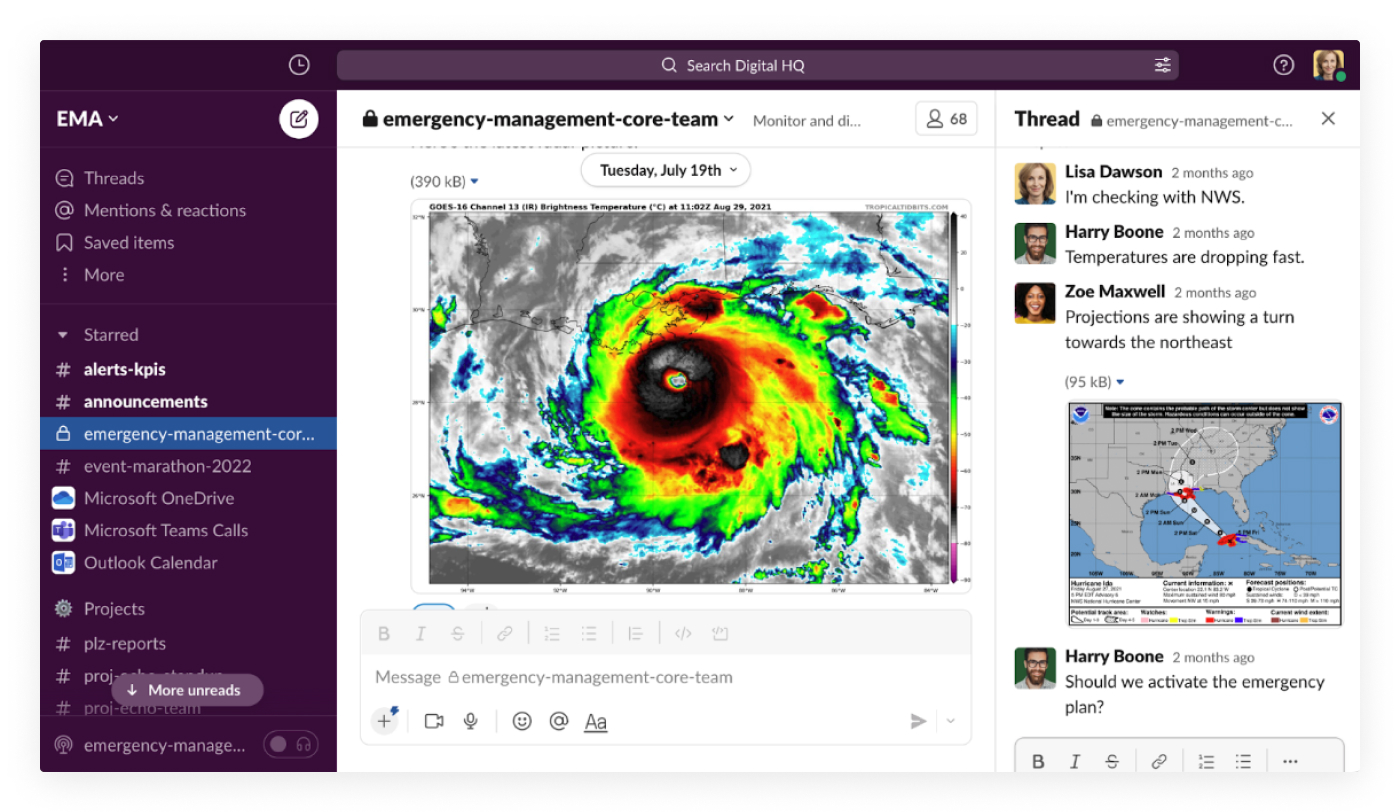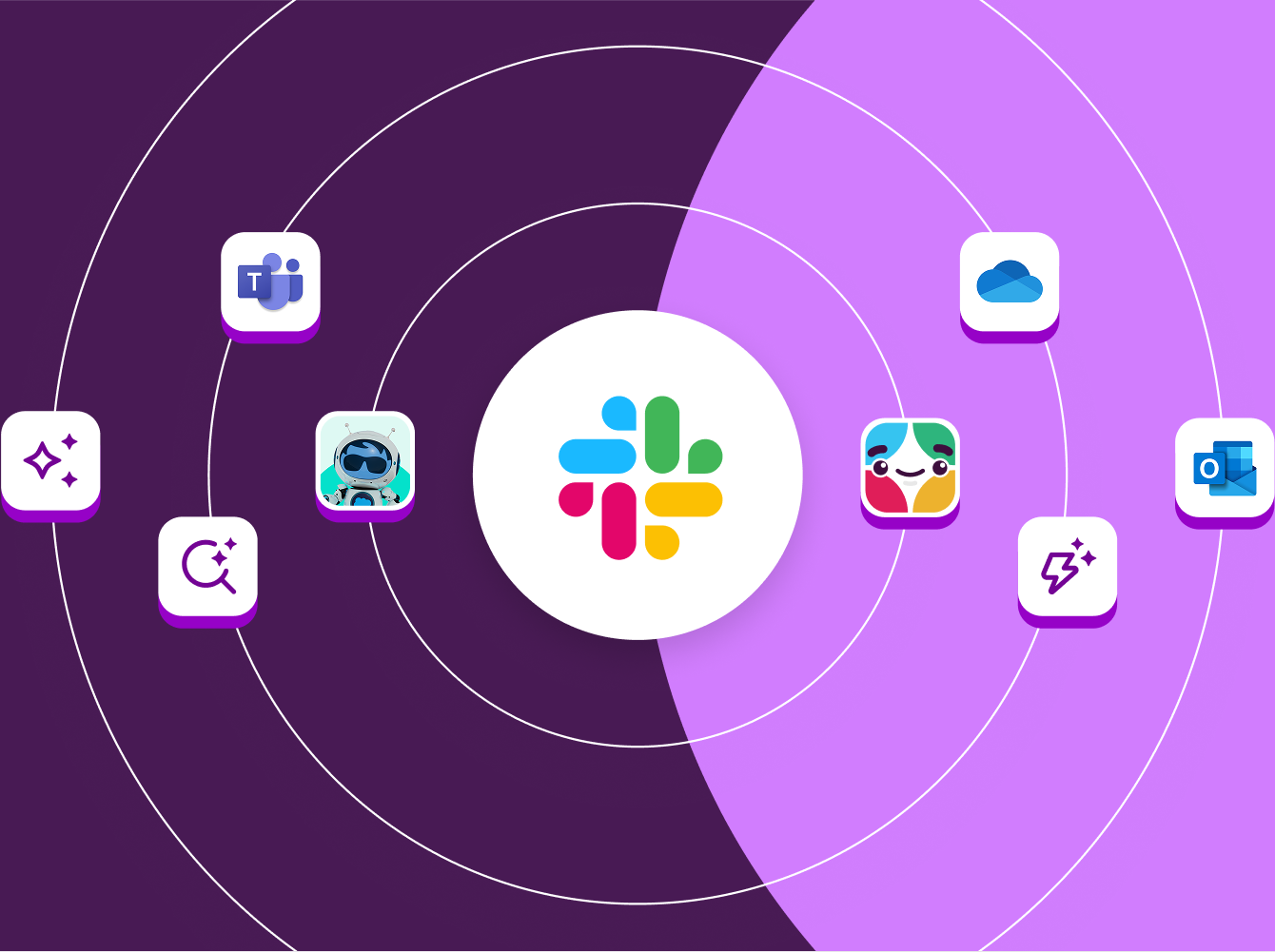Many of the largest and most technical companies in the world use Slack to improve response times and streamline incident management for IT issues like server outages and broken code. But emergency responders have discovered that anticipating, monitoring and managing incidents in Slack is just as applicable for natural disasters and humanitarian crises as for software issues.
The principles that make Slack such an effective platform for swarming IT incidents can be overlaid with the Federal Emergency Management Agency’s (FEMA) National Response Framework to swarm natural disasters and matters of public safety in real time, increasing the potential to save lives and livelihoods.
Instead of disjointed email chains and conference bridges, Slack provides a single, shared source of truth as your Digital HQ.
Recent volunteer-led efforts turned to Slack during the U.S. evacuation of Afghanistan, the humanitarian crisis in Ukraine, and flooding in Kentucky.
There are a few basic best practices learned from those teams that can make Slack a critical component of any emergency response playbook.
Apply for free or discounted Slack plans
Slack offers a free or discounted workspace to nonprofits. Governments, for-profit companies, and individuals can also request a free trial. Slack provided free or upgraded workspaces during these past emergencies.
Slack’s paid enterprise offerings are used by official government-led emergency responses to meet their security and compliance requirements, such as the Freedom of Information Act.
Find critical information when you need it
Slack’s reliability gives you confidence that planning guides, operational plans, and other files will be available during critical events. Files, documents, photos, and videos can be shared from your computer, mobile device, or cloud storage service of choice, all without switching tabs or windows.
Finding the right information is key to working smarter and faster. In Slack, you can quickly find messages, files, channels, and people, all in one search.
Create a clear channel structure
Clarity and speed are critical during an emergency. Help your users know exactly where to go by using prefixes that make a channel’s purpose clear.
Teams responding to floods in Kentucky created channels with the prefix #help-, like #help-supplies, #help-volunteers, #help-donations and #help-cleanup, to connect volunteers where they were needed.
Knowing where things are in Slack even helped users locate key resources in their community. Channels starting with #locations– included #locations-wifi, #locations-hot-meals, #locations-transportation, #locations-shelters and #locations-showers.
Administrators and volunteer leaders in these emergency response workspaces created private internal channels, such as #internal-operations-staff, #internal-admins-security and #internal-escalate, for effective use of Slack as their emergency operations center.
Finally, organization-wide announcement channels allowed their most urgent communications to reach their full audience as fast as possible.

Hartford Police Department uses Slack to increase the speed and accuracy of information distribution
Not long ago, details about suspects were handed out on flyers, only to end up crinkled and stuffed into the visors of police cruisers. Later, daily email bulletin blasts solved the distribution problem but still couldn’t keep pace with events as they happened in the real world.
These days, the Hartford, Connecticut, Police Department’s intelligence sharing is primarily coordinated over Slack with more than 450 investigators and officers from all over the state.
“Slack has completely changed our communication culture and how we distribute information at the Hartford Police Department,” said Special Operations Group Sergeant, Chris Mastroianni.
“Slack is the only platform that has been able to deliver information in real time and parsed out to who needs it.
Slack has also bridged the communication gap not only internally, but with surrounding agencies.”
Use apps and integrations for mission-critical alerts
With more than 2,500 integrations available in the Slack App Directory, many of the tools emergency managers leverage today for incidents are available out of the box.
Need up-to-the-minute status alerts? You can subscribe to both RSS and Atom feeds from emergency management agencies and get updates in the Slack channel of your choice.
Step 1: Install the RSS app
To get started, you’ll need to add the RSS app to your Slack workspace:
- Visit the RSS page in the Slack App Directory.
- Click Add to Slack.
- On the next page, click Add RSS integration.
Step 2: Add a feed
After you’ve added the RSS app, add your first feed:
- Next to Feed URL, paste the web address of the feed you’d like to subscribe to.
- Select a channel where feed updates will appear.
- Click Subscribe to this feed to finish.

Emergency response RSS feeds
Here are some common RSS feeds that emergency response teams install in their Slack channels:
- Cybersecurity and Infrastructure Security Agency (CISA)
Alerts provide timely information about current security issues, vulnerabilities and exploits. Subscribe to CISA RSS feed. - Office of Personnel Management (OPM)
Provides the operating status of the U.S. federal government. Get the OPM Operating Status RSS Feed. - National Weather Service (NWS)
Severe weather warnings and forecasts for specific zones and counties. Subscribe to NWS Atom feeds.

Out of the Box Emergency Response Apps
Emergency response software already owned by your teams become more valuable when incorporated into your Slack Digital HQ through easy to install apps.
For example, WebEOC is one commonly used software that helps teams “prepare and respond to emergencies.”
WebEOC offers integrations with Slack that allow you to send notifications to channels where teams can discuss and respond in real-time.
Even non-technical users can automate emergency response escalations and processes using the no-code Workflow Builder. Workflows in Slack can be as simple or as complex as you’d like, and can even be connected to other apps and services you use.
Workflow example: Collect incident reports in real time
When incidents occur, it can be a challenge to ensure that all the right people are kept in the loop. With Workflow Builder, you can make it simple for people to collect and share time-sensitive information with the right teams, even when the stakes are high.
With this pre-built workflow, people can submit a form to report information about an incident. This information is automatically and instantly shared with the designated team channel

To get started:
- Download the example “Incident Report Workflow”
- Navigate to Workflow Builder and select “Import.”
- Once imported, edit the workflow to make sense for your team.
- Publish and let everyone know about your masterpiece.

Slack’s flexible platform also allows users to integrate their systems and sensors (such as camera feeds) into channels, providing one common operating picture across the organization.
Manage “Settings & Administration” to meet operation security needs
Teams responding to emergencies trust Slack to keep their data secure and meet compliance requirements. Slack’s security features provide more control, visibility and flexibility:
- Identity and device management
Ensure that only the right people and approved devices can access your company’s information in Slack with features like single sign-on, domain claiming, and support for enterprise mobility management. - Data protection
By default, Slack encrypts data at rest and data in transit for all of our customers. We further protect your data with tools like Slack Enterprise Key Management (Slack EKM) , audit logs, and integrations with top data loss prevention (DLP) providers. - Information governance
Slack offer governance and risk-management capabilities flexible enough to meet your organization’s needs, no matter what they are. This includes global retention policies, custom terms of service, and support for eDiscovery.
There are additional controls built into Slack’s workspace administration that teams responding to emergencies should consider applying:
Manage how people join your workspace
By default, people need an invitation to join a Slack workspace. Workspace owners and admins can approve certain email domains to allow anyone with an approved email address to join their workspace. Any email domains you add will be visible on your workspace sign-in page.
Emergency response teams using Slack add the most common domains for agencies they work with to make it easier and faster for new users to sign in.

Add display name guidelines
Teams responding to emergencies need to quickly know who they’re working with, where they come from, and how they can help. Workspaces can provide guidance to users on what information appears in their display name.

Manage channel posting permissions
You can adjust who’s allowed to post to channels or use mentions that notify all channel members. This helps keep large channels, like those used for announcements, on-topic and free from distraction.
Emergency response teams have limited posting in certain channels to ensure that the information they provide is accurate and easily found.

Strengthen public-private partnerships when responding to emergencies
Emergencies require coordination across jurisdictions and responding organizations. FEMA calls for “deeper collaboration with the private sector and nongovernmental organizations” in its National Response Framework.
Slack Connect helps emergency responders meet that call by enabling up to 250 separate organizations to work together from their own workspaces and accounts. In past emergencies, this meant multiple nonprofits, federal agencies and local governments sharing a Slack Connect channel focused on disaster response.
Slack Connect allows each organization to maintain their own security and log-in controls because the user accesses the channel from their home workspace.
Flexible and secure guest access ensures that you can maintain this level of collaboration with any partners or vendors that are not on Slack today.
For example, an EMT can sign in using his username and password with two-factor authentication, while the State Incident Commander logs in through single sign-on using her PIV authentication card. Both can access the shared Slack Connect channel knowing that their organization’s security, retention and file-sharing policies are applied.










